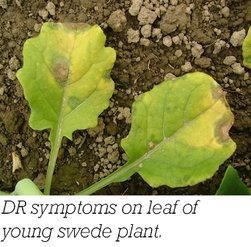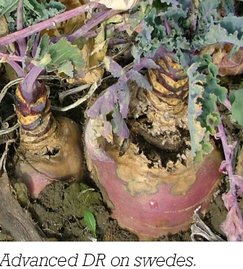Dry rot (DR)
DR, also known as black leg, is caused by the closely related fungi Plenodomus lingam and P. biglobosa. It can be highly destructive in swede, rape and kale, and occurs throughout NZ, most commonly in the lower South Island.
Identification
DR appears as small brown lesions on leaves in summer and autumn. On stems and bulbs, DR develops into large brown-black dry and cracked lesions. On stems, black streaking can develop on the surface tissue. In wet weather, lesions ooze a rose-pink spore mass. Infected leaves die, bulbs collapse and stems break at the lesion.

Importance
DR can be very destructive, causing 100% crop loss in some instances.
Spread
DR over-winters in infected crop residue, and spores can spread up to 1-2 km following rain. DR enters bulbs and stems through growth cracks or insect feeding wounds. Although not common, infected seed can introduce DR into new areas.
Prevention and management
Use cultivars with higher DR tolerance in problem areas, and sow only treated, certified seed. Good crop rotations are essential, with at least a 3 year break before resowing a brassica species. Where DR was noted in a first crop, do not follow with the same crop in the second year. Cultivate thoroughly to ensure full breakdown of crop debris before resowing.


